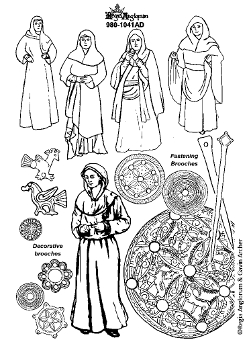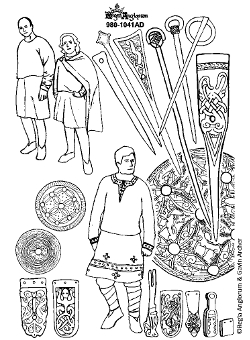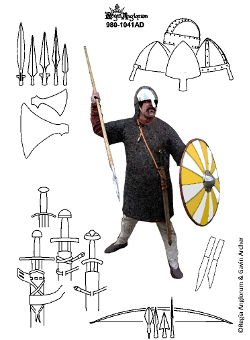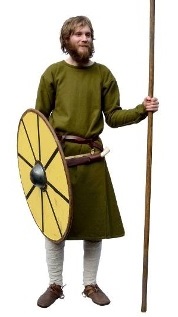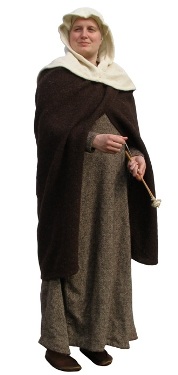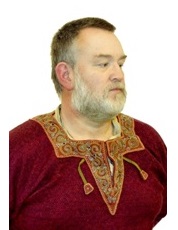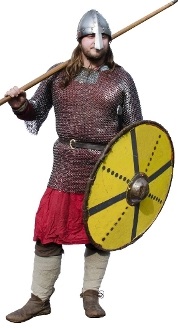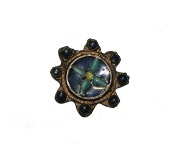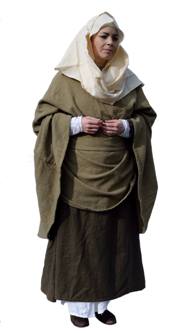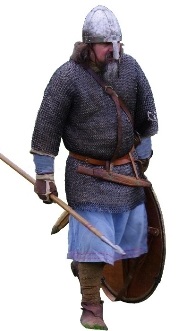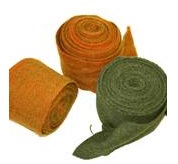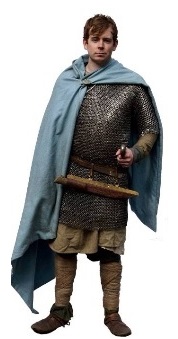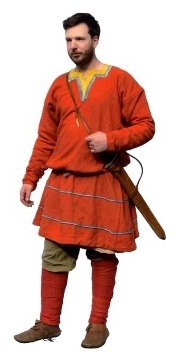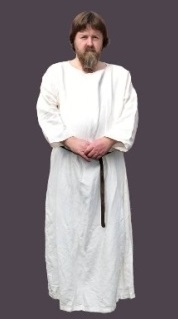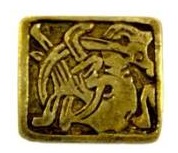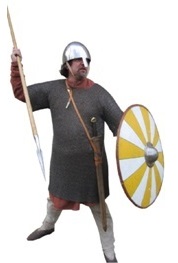Authenticity Officer’s Photo Guide – Examples of Authentic Kit
The Examples of Authentic Kit is a gallery of good examples of authentic kit, and can be used by members as a guide for what to aspire to. However, it is also an open competition amongst the membership, where they can submit photographs of themselves in kit – with examples of the most authentic kit being shown here.
All Periods
All Periods793 - 899
793 - 899900 - 979
900 - 979980 - 1041
980 - 10411042 - 1079
1042 - 10791080 - 1179
1080 - 11791180 - 1215
1180 - 1215The Viking wars of conquest. Æthelred to King Cnut.
As Christians, all women cover their hair when outside the home. In England the hood like wimple is very popular although the traditional long scarf veil is worn both in England and across Europe. The veil is worn loosely draped over the head and wrapped around the shoulders whilst leaving the neck showing.
Most women wear a linen shift. There are a number of different garments that can be worn over this. Most common is an ankle length woollen dress with either sleeves that are loose and cut slightly shorter to expose the cuff of the shift underneath or else with tight sleeves to the wrist. Neck-holes are either round or oval, and can have a keyhole opening. Decoration, in the form of facings, silk strips, embroidery or tablet weave, can be applied to the cuffs. Tied belts of simple braid or cloth can be worn, but never belts of leather.
Sometimes a ‘mantle’ can be worn, which is a woollen conical over garment that can be worn belted with a wide cloth sash. Loose sleeved dresses and mantles are never worn together.
Shoes are of the simple, two-part turn shoe construction and are usually low, coming to below the ankle.
Jewellery is usually of either copper-alloy or pewter, small and for decoration only. Some silver jewellery is still worn, such as the new fashion of wearing a silver penny as a brooch with the cross side always showing. Larger brooches and pins are still used to secure garments. Winchester and Ringerike art styles are popular.
All the Vikings, except those from Sweden, are now predominantly Christian and follow the fashions of Western Europe. The distinctive hangerock and oval brooches are no longer worn and Viking women now cover their hair as do all Christian women.
The primary garment is the tunic. Its skirt comes to the knee cap or just above and it’s always worn tight to the forearm and wrist. Neck-holes are either round, oval or square, and can have a keyhole opening. The square keyhole neck-hole is very fashionable. Decoration, in the form of facings, embroidery, silk strips or tablet weave, can be applied to the cuffs and neck-hole. Embroidery is sometimes applied to the tunic’s skirt but never around its hem. Tunics are usually made from wool but can also be from linen.
Belts can be made from either braided wool or from a leather strap. They can be simply tied or else closed by a buckle of bone, iron or copper-alloy. Belts sometimes have strap-ends attached.
For warmth a cloak can be worn, clasped on the right-hand shoulder by ties or a large disc brooch or pin.
Leg coverings, if worn at all, should be tight to the leg and are usually hose and braies or more rarely trousers. Leg wraps can also be worn. These are long strips of 10cm wide woollen cloth worn wound about the lower leg from the ankle to the knee.
Shoes are of the simple, two-part turn shoe construction and are usually low, coming to below the ankle.
Jewellery is usually of copper-alloy or pewter although some silver is still used. Winchester and Ringerike styles are common.
This is a period of rapid military advancement driven by frequent Scandinavian raids. Weapons and armour are markedly more plain and utilitarian than in previous centuries and the new industrialised towns churn out evermore weapons, helmets and mail shirts.
The conical iron helmet is worn by all but the poorest of warriors. The large round wooden shield is the primary form of defence. During this 60 year period, mail shirts slowly become more numerous, going from being restricted to the wealthy in the 970s to being worn by most professional warriors by the 1040s.
Warriors carry into battle 1 or 2 javelins to throw and a spear to use one-handed and overarm in combat. Additional weapons could include a seax, a large single edged knife; a simple hand axe; or a sword. Swords are both plainer and more plentiful than before and many warriors now carry them. The seax was carried by the English, both as a status symbol and as a weapon of last resort.
Sometime around AD1016 the new terror weapon, the Dane Axe arrives in Britain. A large axe wielded in both hands and deployed to stop mounted warriors. The English are experimenting with fighting from horseback, as is the norm in mainland Europe, but with limited success.
Most arrows are now bodkins, designed to pierce the ever increasing number of mail-shirts. Although bows do not constitute a major part of the battle they are used both in the starting clashes and also in seiges by both attackers and defenders alike.
Every 5 hides of land have to supply a part-time warrior when called upon by the King. The warrior must be adequately equipped with a minimum of a spear, short arm and shield.
MichaelFollowing the rules of the church, her hair is covered by a wimple worn atop a wrap over cloak. Her woollen clothing is undyed. This look can be worn at any Regia event.
LouiseSquare keyhole neck-holes are popular in England and Denmark during the C11th. This example is highly embroidered in Winchester style decoration and would have been worn by a lord.
by Bekka GriffithsThis longhall was built by Regia members on our own permanent site in Kent.
WychurstFor defence he has a mail shirt, a conical helmet and a lenticular shaped round shield. He carries a spear and a Wheeler type 'VI' sword suspended from his belt..
DanThese small and delicate copper-alloy and glass brooches were probably worn as decoration or possibly as protective amulets by women in south-east England, Denmark and Frisia.
by John ShulverA wealthy woman wearing a veil over her woollen mantle. Under this she wears a woollen dress cut slightly short in the arm and skirt to expose a little of the linen undershift beneath.
KatProtected by a mail shirt and conical helmet. He carries a spear, a seax across his front and a Petersen type 'L' sword suspended from a baldric.
AdrianMany men wear leg bindings wrapped around their lower legs. They average 9cm wide, have a natural selvage and are primarily woven in a twill to give them more stretch.
By Liz DabornA professional warrior, with a mail shirt, sword and seax. His woad dyed cloak is closed by an typical English disc brooch.
TomAn aristocrat, sporting the fashionable square necked tunic. The neck hole and skirt of his madder dyed tunic is decorated with bands of silk braid.
TomWorn by acolytes, thurifers and other functionaries across all of Regia's periods.
MartinA Mammen style bird design. Rectangular brooches derive from Carolingian fashion and are generally found in Germany and the Netherlands. A few rectangular brooches have been found in the East of England and may be of local manufacture.
by Roland Williamson